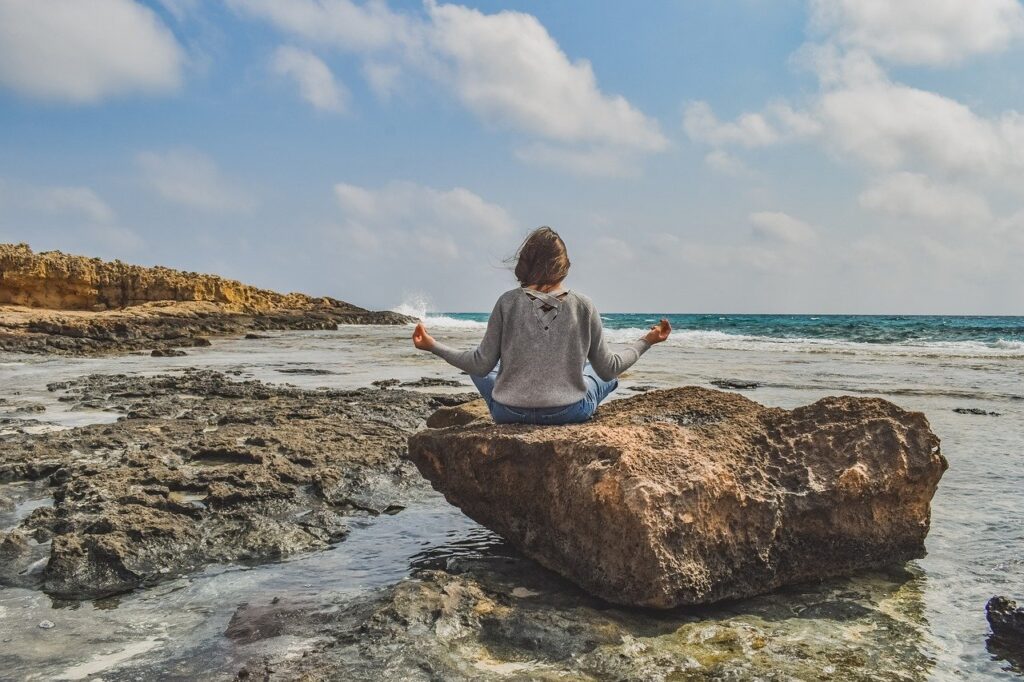What is Meditation / Dhyana?
Meditation is a word that has come to be used loosely and inaccurately in the modern world. That is why there is so much confusion about how to practice it. Some people use the word meditate when they mean thinking or contemplating; others use it to refer to daydreaming or fantasizing. However, Meditation (dhyana) is not any of these.
The word Meditation, is derived from two Latin words : meditari (to think, to dwell upon, to exercise the mind) and mederi (to heal). Its Sanskrit derivation ‘medha’ means wisdom.
Traditionally, the Classical Yoga texts, describe that to attain true states of meditation one must go through several stages. After the necessary preparation of personal and social code, physical position, breath control, and relaxation come the more advanced stages of concentration, contemplation, and then ultimately absorption. But that does not mean that one must perfect any one stage before moving onto the next. The Integral Yoga approach is simultaneous application of a little of all stages together.
Meditation is a precise technique for resting the mind and attaining a state of consciousness that is totally different from the normal waking state. Meditation is a state of thoughtless awareness. It is not an act of doing – it is a state of awareness.

Meditation is effortless and leads to a state of ‘thoughtless awareness’ in which the excessive stress producing activity of the mind is neutralised without reducing alertness and effectiveness. Authentic meditation enables one to focus on the present moment rather than dwell on the unchangeable past or undetermined future.
In meditation, the mind is clear, relaxed, and inwardly focused. When you meditate, you are fully awake and alert, but your mind is not focused on the external world or on the events taking place around you. Meditation requires an inner state that is still and one-pointed so that the mind becomes silent. When the mind is silent and no longer distracts you, meditation deepens.
Meditation is very simple. It is simply attending. You can begin by attending to your breath, and then if a thought comes, attend to it, notice it, be open to it—and it will pass. Then you can come back to the breath.

Meditation teaches you to attend to what is taking place within without reacting, and this makes all the difference. It brings you freedom from the mind and its meandering. And in this freedom you begin to experience who you are. You experience inner joy and contentment, you experience relief and inner relaxation, and you find a respite from the tumult of your life. You have given yourself an inner vacation.
This inner vacation is not a retreat from the world but the foundation for finding inner peace. You must also learn to apply the principle of attending in your worldly activities, so that you can apply yourself in the world more effectively. Through practicing meditation you can learn to be open to what comes before you in your daily life and give it your full attention.
Ordinarily, you react to the experiences that come before you in much the same way that you react to your thoughts. Your mood depends on what comes before you, and, as a result, your life is like a roller coaster ride. You react before you have fully experienced what you are reacting to. You immediately interpret what you see or hear according to your expectation, fears, prejudices, or resistances. You short-circuit the experience, and thus limit yourself to one or two conditioned responses instead of responding to a situation openly and creatively.
In this way meditation is very therapeutic. It not only leads to inner balance and stability, it also exposes your inner complexes, your immaturities, your unproductive reflexes and habits. Instead of living in these complexes and habits and acting them out, they are brought to your awareness and you can give them your full attention. Only then will they clear.

What Meditation is not?
Concentration
Concentration is an effort to fix the attention on a particular object or idea for a long period of time. The techniques used in visualization are another type of concentration.
Loss of control
Sounds, voices, colors and involuntary movements have nothing to do with meditation or spirituality. These are symptoms of loss of awareness and loss of control over some parts of ourselves.
Exercise
Exercises, such as postures and breathing, do not constitute meditation. They may help establish some balance if under the guidance of a true master (a realized soul). Their practice without a true spiritual goal only leads to an imbalance in the right channel.
